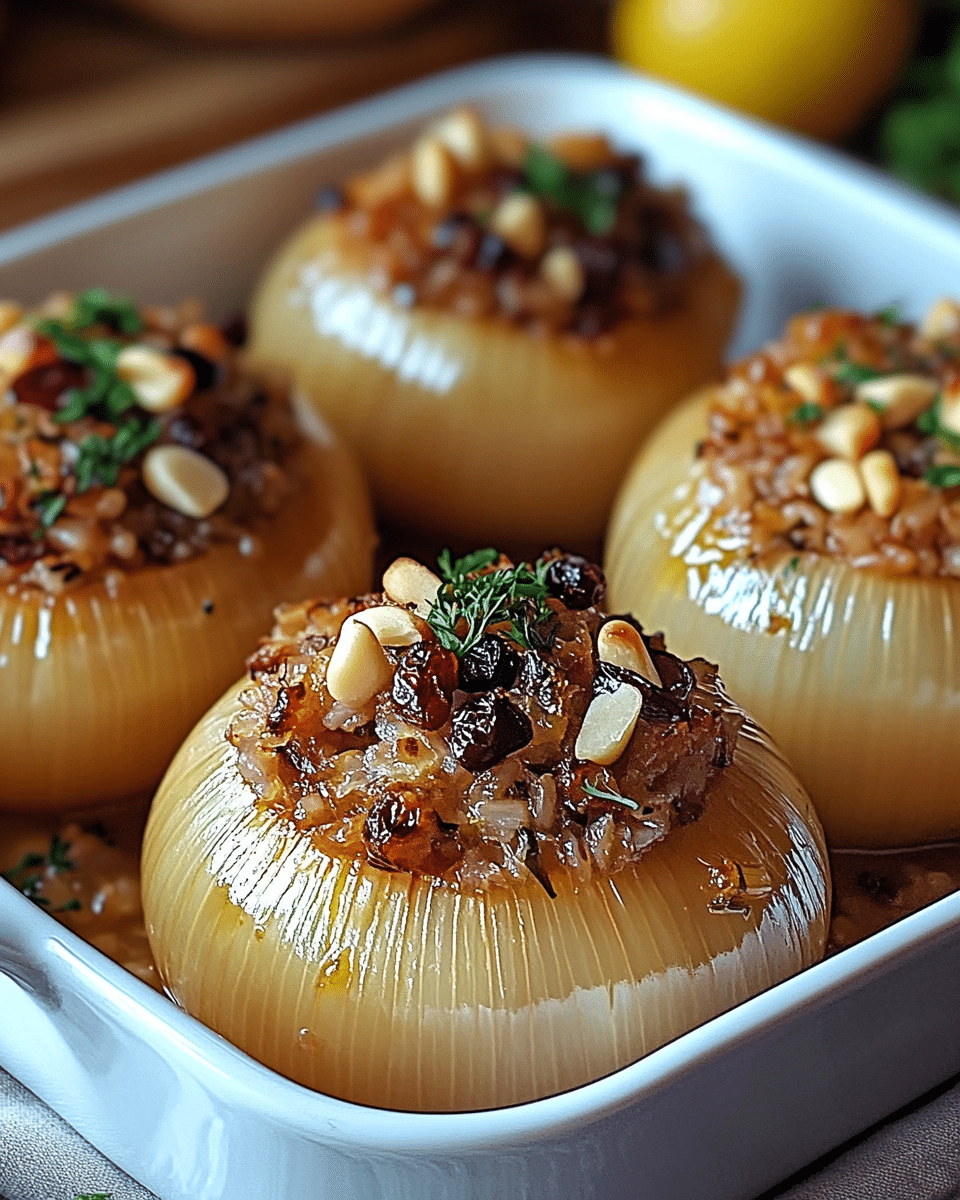The delicate layers of sweet onions become the perfect vessel for a warm, herbed rice filling with pine nuts and currants, bringing a comforting and aromatic taste of Greece to your table. Each bite delivers a medley of lemon brightness, fresh dill, earthy cinnamon, and the nutty crunch of pine nuts, creating a hearty yet elegant dish that feels like a comforting hug in every spoonful. Greek Stuffed Onions are perfect for meal prepping, holiday gatherings, or a cozy family dinner, capturing the essence of Mediterranean flavors while remaining gluten-free and vegan-friendly. This dish shines with fresh herbs and lemon while transforming simple onions into an impressive centerpiece that will have your family and guests coming back for seconds.
Full Recipe:
Ingredients:
-
6 large sweet onions
-
1 cup long-grain rice
-
1/4 cup olive oil
-
1/2 cup pine nuts
-
1/2 cup currants or raisins
-
2 cups vegetable broth
-
1/2 cup fresh dill, chopped
-
1/2 cup fresh parsley, chopped
-
1 teaspoon ground cinnamon
-
1 teaspoon ground allspice
-
Salt and pepper to taste
-
Juice of 1 lemon
-
Zest of 1 lemon
Directions:
-
Preheat your oven to 350°F (175°C).
-
Slice the tops off the onions and carefully hollow them out, reserving the inner layers for the filling.
-
Finely chop the reserved onion layers.
-
In a skillet, heat olive oil over medium heat and sauté the chopped onion until translucent.
-
Add the rice, pine nuts, and currants, stirring for 2-3 minutes.
-
Pour in 1 cup of the vegetable broth, add cinnamon, allspice, salt, and pepper, and cook until the rice is half-cooked.
-
Remove from heat and stir in the fresh dill, parsley, lemon zest, and lemon juice.
-
Fill the hollowed onions with the rice mixture, packing gently.
-
Place the stuffed onions in a baking dish, add the remaining vegetable broth around them, and cover with foil.
-
Bake for 40-45 minutes, removing the foil in the last 10 minutes for a slight golden finish.
Prep Time: 20 minutes | Cooking Time: 45 minutes | Total Time: 1 hour 5 minutes
Kcal: 310 kcal | Servings: 6 servings
Discover the Heart of Greek Cuisine with Stuffed Onions
Greek Stuffed Onions are a beautiful example of how simplicity, seasonal ingredients, and thoughtful preparation can transform everyday vegetables into a centerpiece meal rich with culture and comforting flavors. This dish showcases the essence of Mediterranean eating, emphasizing fresh herbs, wholesome grains, and the brightness of lemon, while using onions as a sweet, tender vessel for a rice-based filling laced with warm spices.
This dish aligns perfectly with modern dietary preferences: it is naturally vegan, gluten-free, and highly nourishing, making it a dish your readers will want to try immediately for family dinners, weekend meal prep, or even special gatherings where a unique yet comforting dish can stand out on the table.
The History and Cultural Roots of Greek Stuffed Onions
In Greek cuisine, stuffed vegetables (gemista) hold a special place, often prepared in large batches for Sunday family lunches or village gatherings. While tomatoes and peppers are most commonly used, onions offer a subtle sweetness and elegant presentation that elevates the meal.
Stuffed onions have roots in regional Greek traditions where using every part of seasonal produce is essential, minimizing waste while maximizing flavor. The practice of hollowing out onions and stuffing them with rice, herbs, pine nuts, and sometimes dried fruits like currants is tied to Greek Lenten traditions, where plant-based meals become a focal point of nourishment and celebration.
The warmth of cinnamon and allspice in the filling echoes the spice routes that influenced Greek culinary traditions, blending seamlessly with the freshness of dill, parsley, and lemon to create a dish that feels deeply comforting while remaining vibrant and light.
Why Greek Stuffed Onions Are the Perfect Wholesome Meal
Greek Stuffed Onions bring several benefits that will attract your health-conscious and flavor-seeking readers:
-
Plant-Based and Gluten-Free: The rice and herb filling is naturally gluten-free and vegan, suitable for a wide range of dietary preferences.
-
Nutrient-Dense: Onions provide antioxidants and prebiotic fibers, while the rice and pine nuts add plant-based proteins and healthy fats.
-
Low Waste: The recipe creatively uses the scooped-out onion layers within the filling, showcasing a sustainable approach to cooking.
-
Meal Prep Friendly: Greek Stuffed Onions reheat beautifully, making them a practical option for batch cooking during busy weeks.
-
Balanced Flavor Profile: The interplay of lemon zest and juice with warm spices and fresh herbs offers layers of flavor without heavy sauces or excessive salt.
-
Versatile Serving Options: This dish can be served warm or at room temperature, paired with a simple Greek salad, crusty bread, or a tangy yogurt dip for added variety.
Flavor Profile: Layers of Comfort and Brightness
What makes Greek Stuffed Onions stand out is the way the onions soften during baking, their natural sugars caramelizing slightly, infusing the rice filling with gentle sweetness. The rice, cooked with olive oil, pine nuts, and currants, absorbs the earthy warmth of cinnamon and allspice while lemon juice and zest add a refreshing contrast, ensuring the dish is never heavy on the palate.
Fresh dill and parsley bring a green, herbaceous lift, while the currants or raisins add pockets of sweetness that complement the savory components, resulting in a dish that feels hearty but not overpowering.
Tips for Perfect Greek Stuffed Onions
While the process is straightforward, these practical tips will help your readers achieve the best results:
-
Choose Sweet Onions: Large, sweet onions are easier to hollow and bake into a tender, melt-in-your-mouth texture.
-
Pre-Cook the Rice: Partially cooking the rice before stuffing ensures it will finish cooking in the oven without becoming mushy.
-
Use Fresh Herbs: Fresh dill and parsley elevate the flavor, but if unavailable, dried herbs can be used in smaller quantities.
-
Bake Covered, Then Uncover: Covering the onions while baking helps them steam gently; uncovering them at the end allows the tops to brown slightly for added texture.
-
Add Lemon Before Serving: A final squeeze of lemon just before serving brightens the dish and enhances the herbs and spices.
Serving Suggestions for Greek Stuffed Onions
Greek Stuffed Onions can be served in many ways depending on the occasion:
-
For a Light Meal: Serve with a crisp cucumber and tomato salad dressed with olive oil and red wine vinegar.
-
For a Hearty Dinner: Pair with roasted potatoes or a lentil soup for added protein and warmth.
-
For Entertaining: Place on a mezze platter alongside hummus, olives, tzatziki, and pita for a beautiful, sharable table spread.
-
As Meal Prep: Pack individual portions with a side of greens for a balanced, easy-to-reheat lunch.
Additionally, they pair well with a glass of dry white wine or sparkling water with lemon to complement the fresh, bright flavors of the dish.
Why Your Readers Will Love This Recipe
Your readers will appreciate this recipe for its:
✅ Ease of preparation with minimal hands-on time
✅ Versatility for various meals and occasions
✅ Impressive presentation for gatherings
✅ Clean, whole-food ingredients
✅ Warm, comforting flavors without heaviness
✅ Mediterranean authenticity with a modern, approachable twist
Whether your readers are seasoned home cooks or beginners looking to explore Greek cuisine, Greek Stuffed Onions provide a gateway into Mediterranean cooking, making them feel confident and excited about preparing nourishing, delicious meals at home.
Adapting Greek Stuffed Onions to Your Taste
Encourage your readers to experiment by:
-
Swapping pine nuts for chopped walnuts or almonds if desired.
-
Adding sautéed greens like spinach or chard to the rice filling for extra vegetables.
-
Using wild rice or brown rice for a nuttier, chewier texture.
-
Including feta crumbles before serving for a vegetarian but non-vegan option.
-
Drizzling with pomegranate molasses for a sweet-tangy finish.
Conclusion:
Greek Stuffed Onions are more than a recipe; they are a reflection of the Greek way of cooking and living: simple ingredients prepared with care, embracing the natural flavors of seasonal produce while respecting the body’s need for nourishing, satisfying meals.
This dish can easily become a go-to in your readers’ kitchens, serving as a comforting yet vibrant option for weeknight dinners, potluck contributions, or even festive holiday meals where something unique yet familiar is desired. It allows cooks to slow down, enjoy the process, and share a piece of Mediterranean warmth with loved ones around the table.






